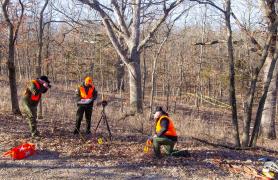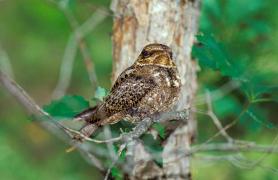Less than one-half of one percent of Missouri’s original 15 million acres of prairie remain. The biomass that extended from the tips of their roots 8 to 10 feet underground to the grasses that waved over the heads of horseback riders has receded from the landscape. We are only now beginning to fathom what has been lost.
The voices captured here belong to Missourians whose work helps us understand and restore pieces of the vast grassland that once made up one-third of our state.
The Hunter
Rudi Roeslein
The head of a massive bull elk overlooks the light-filled living room of Rudi Roeslein’s log home near Linn. It is one of many trophy mounts that testify to Roeslein’s passion for hunting.
When he acquired his property in 1992, he set out to manage it for wildlife with the help of then MDC Private Land Services (PLS) Biologist Jennifer Battson. He showed her around the acreage and remembers Battson saying, “Wow, Rudi, that’s a lot of clover. That’s a lot of fescue.” She assured him there was nothing “wrong” with those plants, but to ensure good wildlife populations, he needed successional plants, including tall grasses that allowed space for nesting and for young quail and turkey chicks to chase bugs.
In 2008, he acquired 1,100 acres in north Missouri and enlisted another PLS biologist, John Murphy, for guidance. He told Murphy he wanted habitat for deer and turkey, but also pollinators.
“It’s like an evolution,” he said. “First, the hunter wants to catch and kill his limit. Then he wants that trophy animal. Then there is a gradual awakening and he sees the butterflies, the birds, the minute little bugs that share that habitat and he realizes, you have to have it all in balance in order to survive and thrive.”
Twelve years later, he has 500 acres of restored and reconstructed native grasses and forbs and 600 acres of savannah. Now his goal is to convert 30 million acres of land to prairie in 30 years.
He wants to restore not only prairie, but the prosperity of rich north Missouri farmland.
Roeslein is working with Argon Laboratories and the California Air Board to quantify the value of carbon sequestration by prairies for possible trade in carbon tax credits. Soil and water erosion tax credits would give native prairies the commercial value to compete with crops on land that is highly erodible and should not be planted into corn and beans.
“This value chain would give farmers a much needed diversification into renewable energy and provide ecological services that would add value to society, the farmers, and wildlife,” said Roeslein.
The Family Business
Hamiltons Native Outpost
Amy and Rex Hamilton met while working at the Soil Conservation Service (what is now the Natural Resources Conservation Service). They shared an interest in conservation practices and respect for the farmers they served, who were trying to improve their land — and profit — by working with nature.
“Historically, overgrazing was a major problem,” said Amy. “Then along came fescue. It stands up well in winter and responds to fertilizer, so a lot of people adopted it. But it also has an endophyte that produces a toxin that causes high temperatures in cattle.”
“Fescue also has an inhibitory effect on soil health,” added her daughter, Elizabeth Steele. “It isn’t as deeply rooted as warm season grasses, which limits its ability to form organic matter in the soil. And its thick mat eliminates habitat for quail and other ground-nesting birds.”
The solution? Native grasses and wildflowers. The Hamiltons began harvesting and selling native plant seeds in 1981. Steele cites a study showing that a diverse field of native cool season grasses, warm season grasses, legumes, and wildflowers is 238 percent more productive than a monoculture.
“It all comes down to how we are going to feed an expanding population,” said Amy. “We have to figure it out, and soil health is the basis.”
Amy reflected on the balance of nature that evolved on the prairie.
“Prairies aren’t being made anymore,” she continued. “The patterns that huge herds of bison laid on the land are long gone. We can’t go back. But if grazing is done well, it can improve the health of the animals, the soil, and habitat for wildlife.”
The Rancher
Dave Haubein
Dave Haubein is the fifth generation using his family’s land to make a living in the southwest Missouri community of Lockwood. Farmer, rancher, and businessman, Haubein retired in 2011 so he could devote more time to restoring his grazing land and practicing new soil health techniques on row crops.
About half of his 4,800-acre farm is in row-crops and half is in pasture. His cattle, Angus and Hereford/Angus crosses, spend their summers relishing warm season native grasses that Haubein restored. He planted forbs for diversity and established “rest areas” that are never planted or grazed, but remain available for pollinators. In the winter, the cattle transition to cover crops that have been planted after his row crops are harvested.
Seed for the cover crops are planted into the corn and soybean residue without plowing. The grazing cattle stimulate the soil with their hooves and manure, impacting the land much like the bison that grazed on the prairie more than a century ago.
Haubein says he is really impressed with the weight gains his cattle make using this strategy. “From an economic standpoint, we feel we’re headed in the right direction.”
The National Audubon Society consulted with Haubein and other producers in 2006 as they began to develop their Conservation Ranching program. It is intended to link ranchers with the emerging market for grass-fed beef while restoring native grasslands for bird habitat.
“Eighty-five percent of grass-fed beef you see in the stores is imported,” Haubein said. “There’s growing demand for local, humanely produced meat without antibiotics or hormones.”
MDC’s Private Land Services Biologist Rick Rath helped Haubein develop a habitat management plan that follows Audubon protocols. Haubein consulted NRCS for help with crop advice and soil health. He is learning that the combined strategies benefit the herds as well as the birds.
“You have to factor in the benefits of soil health and the enjoyment you get from wildlife to fully embrace the Audubon program,” Haubein said.
He believes ranchers around the state could replicate what he is doing. Some of his neighbors, in fact, are doing just that. Prairie bird populations are responding. Quail, scissor-tailed flycatchers, and shrikes are coming back.
The Teacher
Kevin Mouser
Kevin Mouser takes his students to the prairie at least four times a year. Though they have grown up surrounded by farm fields, forests, rivers, and streams in the scenic southwestern community of Noel, they are amazed at the diversity of life on the prairie.
“Our first visit is a ‘drive-by,’” Mouser said. “I ask them to take cell phone pictures as we slowly pass it. The pictures will be context for our next, in-depth visit so they can see the difference between seasons.”
The next visit is usually after a burn. (Prairies need to be burned regularly to eliminate the accumulation of dead plant material from previous years’ growth.)
“The kids think the prairie has been destroyed, but the following visit just takes their breath away, seeing all the flowering plants that return after a burn.
“I tell them to fan out, as far as they can go and still see me,” he said. The kids crawl around on their hands and knees, discovering the variety of life found among the native plants.
Their outdoor laboratories are Diamond Grove Prairie, a conservation area, and Carver Prairie, owned and managed by the Missouri Prairie Foundation. There they learn the principles of mutualism and symbiosis — how plants and animals depend on each other for the benefit of both — and the difference between conservation and preservation.
They may also get to visit Prairie State Park to study how bison have used and impacted prairie over millennia. Mouser shows the students how the deep roots of prairie grasses, such as big bluestem, can sequester carbon, and how legumes use bacteria to create nitrogen.
“They really make the connection between what we’ve studied in class with what they find on the prairie.” The students are a study in diversity themselves — white, Hispanic, Somali, Pacific Islanders, Thai — and they marvel at the benefits of diversity on the prairie. A species count is always part of the curriculum and includes plants, birds, insects, mammals, and reptiles.
“We talk about self-supporting networks on the prairie,” Mouser said. “They count the number of plants visited by hummingbirds, for example, or look at monarch eggs on milkweed. It’s all about teaching them how all the organisms are working together for mutual benefit.”
The Scientist
Alice Tipton
Alice Tipton was a self-described “weird kid” growing up in St. Louis. Her heroes were Rachel Carson and Jane Goodall. She wanted to help save the planet when she grew up and assumed she would have to move to a tropical rain forest or coral reef to make a difference. Instead, she discovered the creatures that lived beneath her feet were just as interesting.
She learned, for example, that the microorganisms that live in soil make plant growth possible by channeling water and nutrients through the soil to plant roots. Without the interaction between the organisms and plants, life on earth would not exist.
Tipton’s research on the mycorrhizal fungi of remnant prairie soils is helping landowners manage and restore critically important native landscapes. New advances in DNA testing allow Tipton to identify and trace thousands of mycorrhizal fungi. These fungi interact with more than 80 percent of the plants on earth. They help plants get nutrients from the soil and the plants provide the fungi with sugar. This “mutualism” is found in every habitat in Missouri, yet it is poorly understood.
Tipton discovered that some of the remnant prairie fungi were less common or absent in places that had been farmed in the past. This might be because tilling or fertilizers change the relationship between the plants and fungi. Introducing fungi from remnant prairie soils may improve conditions for native plants.
As a biology professor at Lincoln University, Tipton explains the link between plants and fungi to her students by taking them to the school’s farm, where stands of native grasses offer a hint of the vast prairie landscape that greeted settlers 200 years ago.
To find a prairie near you, visit MDC’s Places to Go online at short.mdc. mo.gov/Z4V. You can also visit the Missouri Prairie Foundation website, moprairie.org. For technical information about prairies, visit short.mdc. mo.gov/Znq.
- 60,000: Acres of prairie left, out of 15 million.
- 2.5 trillion: tons of carbon in the soil, compared with 800 billion tons in the atmosphere.
- 46: the world record num ber of plant species found in one 20- by 20-inch square on a Missouri prairie.
The number of species that depend on prairie habitat:
- Insects: 728
- Birds: 19
- Mammals: 7
- Reptiles and amphibians: 20
















Also In This Issue


And More...
This Issue's Staff
Editor - Angie Daly Morfeld
Associate Editor - Larry Archer
Staff Writer - Bonnie Chasteen
Staff Writer - Heather Feeler
Staff Writer - Kristie Hilgedick
Staff Writer - Joe Jerek
Art Director - Cliff White
Designer - Shawn Carey
Designer - Les Fortenberry
Designer - Marci Porter
Photographer - Noppadol Paothong
Photographer - David Stonner
Circulation - Laura Scheuler






















